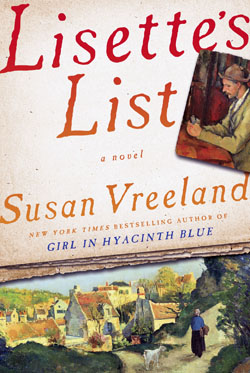Susan Vreeland, Lisette’s List, 2014, Random House, ISBN 978-1-4000-6817-3, $27
By Donald H. Harrison

 SAN DIEGO –Have you ever watched an artist at his or her canvas? While you might be impatient to see how the painting will turn out, the artist may spend what you feel is an inordinate amount of time making sure that this or that detail is just right. However, the painting is the artist’s creation, not the spectator’s, and the artist is entitled to spend whatever time may be necessary to fulfill his or her vision.
SAN DIEGO –Have you ever watched an artist at his or her canvas? While you might be impatient to see how the painting will turn out, the artist may spend what you feel is an inordinate amount of time making sure that this or that detail is just right. However, the painting is the artist’s creation, not the spectator’s, and the artist is entitled to spend whatever time may be necessary to fulfill his or her vision.
I reminded myself of this lesson once or twice as I read an advance copy of Susan Vreeland’s latest novel, Lisette’s List, which Random House plans to publish on August 26th. I had become so intrigued by the love and mystery story that Vreeland had used as a plot device that from time to time I was ready to dispense with the art appreciation lessons and get right to the denouement of the plot.
Luckily, Vreeland couldn’t hear my thoughts, because now that I look back at it – knowing how the story turns out – I realize that Vreeland’s passion for art, her attention for detail, her exploration of nuance, combined to make this book memorable in a way that the plot alone could not have. I found out not only who dunnit and which guy got the girl, but I also learned quite a bit about some of Vreeland’s favorite artists, including two who were Jewish, Camille Pissaro and Marc Chagall.
So, just a few words about the plot should suffice. Lisette, who grew up in a Paris orphanage, loves to go to museums, and falls in love and marries a frame maker, who is quite knowledgeable about art. She moves with him to the French countryside because his grandfather, a rough-hewn art connoisseur is ailing. The grandfather used to sell the ochre dug out of local mines for use as pigments, and thereby met many artists and heard stories about many more. Along the way, he obtained some magnificent paintings by artists whose reputations grew over time. Imagine, a provincial owning paintings by Pissarro, Cezanne, and Chagall. Not just a collector, but an appreciative audience for artists, the grandfather collected stories and insights about these painters, which he passed on to Lisette, the ever-eager art student.
When the grandfather died, the paintings were inherited by Lisette’s husband, who was among the first to volunteer to fight with the French against the Germans. Knowing that the Nazis would either confiscate the paintings for their own private collections, or destroy them as “degenerate art” prompted the husband, Andre, to hide the paintings. Parisian through and through, Lisette wanted desperately to be able to return to Paris, where art and culture could be found on every street corner, but even after the war and the death of her husband, desire to find the hidden paintings kept her in the countryside, to which she had gradually adjusted and came to love.
As I mentioned, two men competed for her affections: one who had been Andre’s best friend, and was himself a devotee of the arts; the other, the provincial constable, who kept popping up at awkward moments of Lisette’s life.
Don’t get hung up in that story, as I confess I did. Listen instead to Vreeland as she tells of the lives and works of the famous artists whose works Lisette sets out to recover.
*
Harrison is editor of San Diego Jewish World. He may be contacted at donald.harrison@sdjewishworld.com